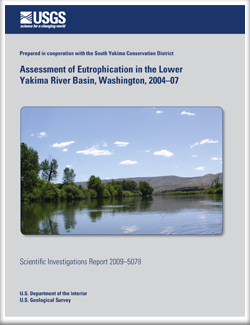 Abstract Abstract
In response to concerns that excessive plant growth in the lower Yakima River in south-central Washington was degrading water quality and affecting recreational use, the U.S. Geological Survey and the South Yakima Conservation District conducted an assessment of eutrophication in the lower 116 miles of the river during the 2004–07 irrigation seasons (March - October). The lower Yakima River was divided into three distinct reaches based on geomorphology, habitat, aquatic plant and water-quality conditions. The Zillah reach extended from the upstream edge of the study area at river mile (RM) 116 to RM 72, and had abundant periphyton growth and sparse macrophyte growth, the lowest nutrient concentrations, and moderately severe summer dissolved oxygen and pH conditions in 2005. The Mabton reach extended from RM 72 to RM 47, and had sparse periphyton and macrophyte growth, the highest nutrient conditions, but the least severe summer dissolved oxygen and pH conditions in 2005. The Kiona reach extended from RM 47 to RM 4, and had abundant macrophyte and epiphytic algae growth, relatively high nutrient concentrations, and the most severe summer dissolved oxygen and pH conditions in 2005.
Nutrient concentrations in the lower Yakima River were high enough at certain times and locations during the irrigation seasons during 2004–07 to support the abundant growth of periphytic algae and macrophytes. The metabolism associated with this aquatic plant growth caused large daily fluctuations in dissolved oxygen concentrations and pH levels that exceeded the Washington State water-quality standards for these parameters between July and September during all 4 years, but also during other months when streamflow was unusually low. The daily minimum dissolved oxygen concentration was strongly and negatively related to the preceding day’s maximum water temperature—information that could prove useful if a dissolved oxygen predictive model is developed for the lower Yakima River.
Periphytic algal growth generally was not nutrient-limited and frequently reached nuisance levels in the Zillah reach, where some surface-water nutrient concentrations were below the reference concentrations suggested by the U.S. Environmental Protection Agency. Although lowering nutrient concentrations in this reach might limit periphytic algal growth enough to improve dissolved oxygen and pH conditions, ground water inflow at some locations might still provide an adequate supply of nutrients for periphytic algal growth.
Macrophyte growth in the Kiona reach was dominated by water stargrass (Heteranthera dubia), was far greater compared to the other two reaches, varied greatly between years, and was negatively related to greater spring runoff due to lower light availability. Lowering nutrient concentrations in the Kiona reach might not impact the level of macrophyte growth because macrophytes with extensive root systems such as water stargrass can get nutrients from river sediment. In addition, the results from this study did not indicate any nutrient uptake by the macrophytes from the water column (nutrient uptake from the sediment was not examined). Creating the prolonged turbid and deep conditions during spring necessary to suppress macrophyte growth in this reach would not be possible in years with low streamflow. In addition, because of the relatively stable substrate present in much of this reach, the macrophyte root systems would likely not be disturbed under all but the most extremely high streamflows that occur in the lower Yakima River.
|
Part or all of this report is presented in Portable Document Format (PDF); the latest version of Adobe Reader or similar software is required to view it. Download the latest version of Adobe Reader, free of charge. |